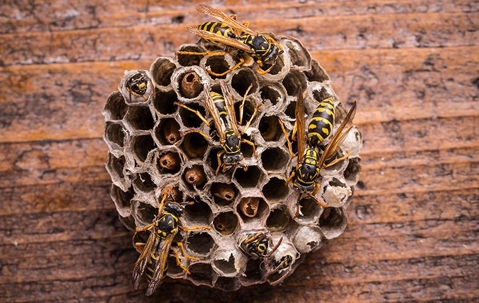No matter where you live, wasps are no fun. Here in Columbus, OH, they can be a particular problem for homeowners, especially during the warmest months of the year. While wasps are beneficial to the environment in many ways (they’re pollinators and predators of pest insects), they’re generally not a welcome sight on your property.
Not only do these insects build large, ugly nests all over your home, but they can inflict a nasty sting. Even worse, some wasp species can get extremely aggressive when defending their nests, swarming perceived threats and sometimes chasing them short distances. These insects also pose a significant risk to those who suffer allergies to insect venom, as they’re one of the most common causes of insect-related anaphylaxis. With all this, it’s safe to say you don’t want these bugs flying around your house – so let’s talk about how to prevent just that.
How To Tell A Wasp From A Bee
We’ve got lots of wasp varieties here in Ohio, including yellowjackets, paper wasps, bald-faced hornets, mud daubers, and more. However, even though all these wasp varieties have unique looks and behaviors, they all share a few common attributes that make them readily distinguishable from common bee species in our area.
One big way to identify wasps is to look at the shape of their bodies. Wasps are slenderer and more streamlined than bees, which are normally pretty fat and round. Wasps also have a narrow, cinched waist, whereas bees do have segmented body parts the same as any insect – they don’t have a defined middle. Even if you can’t get close enough to look at the body shape, if your buzzing insect is long and narrow, it’s probably a wasp instead of a bee.
If you can get up close to your specimen, look for hair. Bees are fuzzy all over, including hairy legs designed to pick up as much pollen as possible. Wasps, meanwhile, are generally shiny and hairless. Also, take a look at the wings of your insect. Just like they have shorter, fatter bodies, bees have shorter, fatter wings than wasps.
Wasp Prevention
There are lots of things you can do to discourage wasps from setting up shop on your property. Getting rid of their food sources is a big way. Don’t overwater or overplant flowers that wasps might use for food (such as fruit trees or flowers that bloom primarily during the day). Do something about infestations that might attract wasps. If you’ve got a problem with insects or arachnids that wasps prey on or use to feed their larvae – like caterpillars, aphids, and spiders – it could attract them in large numbers. Also, keep outdoor garbage cans covered against less picky wasp species like yellowjackets.
Another good prevention method is reducing spots for wasps to nest. Trim bushes and trees back as far as you can to make it harder for hornets and paper wasps to set up shop. Fill in abandoned rodent holes, as yellowjackets and other ground-nesting wasp varieties like to move into these and other deep, undisturbed holes in the ground. Treat exterior wood areas of your house with eucalyptus, citronella, or teak oil to keep mud daubers from building there.
Unfortunately, sometimes even these measures aren’t enough to repel wasps. If you notice nests on your property, never try to deal with them yourself. Many wasp species are extremely aggressive, and they can all sting multiple times. It’s better to avoid the risk and call the pros. Here at 1st Response Pest Management, we’ve got 15 years of experience in safe and effective wasp removal. Our pest control process includes a free inspection, initial treatment, and regular follow-up service to ensure the pests stay gone for good. So give us a call at either 614-888-BUGS (2847) or (614) 591-8745, or visit our contact page to schedule your inspection.

